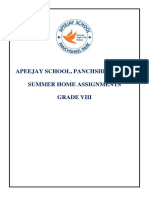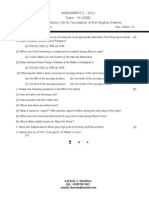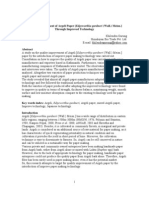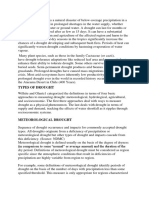ICSE Class 8 Geography Sample Paper 2
ICSE Class 8 Geography Sample Paper 2
Uploaded by
Naman GuptaCopyright:
Available Formats
ICSE Class 8 Geography Sample Paper 2
ICSE Class 8 Geography Sample Paper 2
Uploaded by
Naman GuptaOriginal Title
Copyright
Available Formats
Share this document
Did you find this document useful?
Is this content inappropriate?
Copyright:
Available Formats
ICSE Class 8 Geography Sample Paper 2
ICSE Class 8 Geography Sample Paper 2
Uploaded by
Naman GuptaCopyright:
Available Formats
ICSE Board
Class VIII
Geography
Sample Paper - 2
Time: 2 hrs Total Marks: 80
GENERAL INSTRUCTIONS
1. Answers to this Paper must be written on the paper provided separately.
2. You will not be allowed to write during the first 15 minutes.
3. The time given at the head of this Paper is the time allowed for writing the answers.
4. Attempt all questions from Section A and Section B
5. The intended marks for questions or parts of questions are given in brackets [ ].
SECTION A
QUESTION 1
Fill in the Blanks: [10]
i) is the closest star to the Earth after the Sun.
ii) clouds indicate fair weather.
iii) winds are also known as the anti trade winds.
iv) When the relative humidity of air is 100%, the air is said to be .
v) The Mediterranean Sea is located to the south of .
vi) The coniferous forests of Europe supply for the paper industry.
vii) The highest point in Asia is and the lowest point is .
viii) All stars except the appear to move from east to west.
ix) The Earth’s surface is heated by units of total solar radiation during
the day.
x) The deflection of the winds due to the Coriolis Effect is greater at the and
least at the .
QUESTION 2
Pick the correct answer from the options: [5]
i) The most common method of sowing wheat in Punjab is
a) Broadcasting
b) Drilling
c) Transplanting
d) Dibbling
ii) Which is the southernmost tip of the Indian mainland?
a) Kochi
b) Indira Point
c) Kanyakumari
d) Thiruvananthapuram
iii) Which country is the leading producer of mica in the world?
a) India
b) Malaysia
c) Indonesia
d) China
iv) Which of the following factors affect/s the rate of evaporation?
a) Humidity
b) Temperature
c) Winds
d) All of the above
v) In India, wheat is sown during the months of
a) October - November
b) March - April
c) June - July
d) August – September
QUESTION 3
State whether true or false. [5]
i) The Scandinavian countries have a high population density. (True/False)
ii) The Elburz and Zagros mountains converge at the Armenian Knot. (True/False)
iii) Intensive subsistence agriculture involves the use of mechanised farming.
(True/False)
iv) The Purvanchal Range comprises of the Aravalli Hills. (True/False)
v) In India, wheat is grown as a kharif crop. (True/False)
SECTION B
QUESTION 4
Answer the questions in brief. [20]
i) What do we understand by the term ‘Green Revolution’?
ii) Though the Sun rises two hours earlier in Arunanchal Pradesh than in Gujarat, the
watch displays the same time. Give reason.
iii) Mention six main elements of weather and climate.
iv) What is relative humidity?
v) What are fjords? In which European country do we generally find them?
vi) Why is the Rhine considered to be the most important waterway of Europe?
vii) Which Asian countries were former members of the USSR?
viii) What is extensive commercial agriculture?
ix) What are the climatic conditions required for the growth of a tea plantation? Name
any two major tea producing states.
x) Which are the main tea growing regions in Kerala?
QUESTION 5 [40]
Answer the following:
i) Why is Punjab considered to be ideal for the cultivation of wheat?
ii) On an outline map of India, mark the states through which the Tropic of Cancer
passes.
iii) Answer the following questions:
a) What is an intermontane plateau?
b) Name two intermontane plateaus in Asia.
c) Name the mountain ranges which enclose these intermontane plateaus.
iv) Elaborate on the Great River Valleys of India.
v) Write a short note on the dairy industry in Europe.
vi) Write a short note on the Central Plains or the Great European Plains.
vii) Write a short note on the orographic rainfall.
viii) On an outlined map of Asia, mark the following countries:
a) Mongolia
b) Afghanistan
c) Thailand
d) Cambodia
e) Iran
f) Kazakhstan
g) South Korea
h) Turkey
You might also like
- Rural BankingDocument134 pagesRural BankingAvinash Undre Manikrao87% (23)
- Cage Free Egg ProductionDocument19 pagesCage Free Egg ProductionRi rimottoNo ratings yet
- Jayanti Sengupta Oxford History & Civics Solution Class 8 Chapter 1 The Beginning of The Modern WorldDocument8 pagesJayanti Sengupta Oxford History & Civics Solution Class 8 Chapter 1 The Beginning of The Modern WorldSarah HopeNo ratings yet
- ICSE Class 8 Geography Sample Paper 2Document4 pagesICSE Class 8 Geography Sample Paper 2Naman Gupta100% (1)
- Jayanti Sengupta Oxford History & Civics Solution Class 8 Chapter 3 The Age of RevolutionDocument10 pagesJayanti Sengupta Oxford History & Civics Solution Class 8 Chapter 3 The Age of RevolutionAmmolh MahajanNo ratings yet
- Jayanti Sengupta Oxford History & Civics Solution Class 8 Chapter 2 The Industrial Revolution and The Rise of ImperialismDocument9 pagesJayanti Sengupta Oxford History & Civics Solution Class 8 Chapter 2 The Industrial Revolution and The Rise of ImperialismAmmolh MahajanNo ratings yet
- ICSE Selina Class 8 Chemistry Chapter 2Document10 pagesICSE Selina Class 8 Chemistry Chapter 2Den Angelica DungoNo ratings yet
- When People Rebel WORKSHEETDocument2 pagesWhen People Rebel WORKSHEETJiya Kushwaha100% (2)
- Specimenn Paper 2024Document10 pagesSpecimenn Paper 2024Arka OfficialNo ratings yet
- cls-7 Eng 1and2Document6 pagescls-7 Eng 1and206 HANSHI BHAKUNINo ratings yet
- Jayanti Sengupta Oxford History & Civics Solution Class 7 Chapter 4 The Turkish Invasion and The Establishment of The Delhi SultanateDocument10 pagesJayanti Sengupta Oxford History & Civics Solution Class 7 Chapter 4 The Turkish Invasion and The Establishment of The Delhi Sultanatesikandarali2012100% (1)
- ICSE Class 10 History 2002Document5 pagesICSE Class 10 History 2002Adnan KhanNo ratings yet
- Class 6 EnglishDocument66 pagesClass 6 EnglishRahul SinghNo ratings yet
- Class 8 EnglishDocument4 pagesClass 8 EnglishSakil Mahmud100% (1)
- Class 8 Worksheets All SubjectsDocument17 pagesClass 8 Worksheets All SubjectsAahana KapoorNo ratings yet
- ICSE Solutions For Class 6 History and Civics - Rise of Kingdoms and Republics - ICSE SolutionsDocument16 pagesICSE Solutions For Class 6 History and Civics - Rise of Kingdoms and Republics - ICSE Solutionspriyadarshi mishraNo ratings yet
- Icse Class 8 Chemistry Sample Paper Set 2Document3 pagesIcse Class 8 Chemistry Sample Paper Set 2Prashant DhotreNo ratings yet
- ICSE GeographyDocument7 pagesICSE GeographyDimple VermaNo ratings yet
- ICSE Class 8 Physics Sample Paper 2Document5 pagesICSE Class 8 Physics Sample Paper 2madhumitra mohantyNo ratings yet
- History and Civics1 PDFDocument26 pagesHistory and Civics1 PDFArter KingNo ratings yet
- ICSE Class 7 Mathematics Sample Paper Set 1Document4 pagesICSE Class 7 Mathematics Sample Paper Set 1Chahat SyalNo ratings yet
- 7 History 1Document9 pages7 History 1Nikunj KoladiyaNo ratings yet
- CBSE Class 7 Geography Chapter 7 Notes - Human Environment - Settlement, Transport and Communication PDFDocument7 pagesCBSE Class 7 Geography Chapter 7 Notes - Human Environment - Settlement, Transport and Communication PDFTottleNo ratings yet
- CBSE NCERT Solutions For Class 7 Science Chapter 4: Back of Chapter QuestionsDocument4 pagesCBSE NCERT Solutions For Class 7 Science Chapter 4: Back of Chapter QuestionsPugalmeena PugalmeenaNo ratings yet
- ICSE Class 10 Geography Question Paper 2015Document7 pagesICSE Class 10 Geography Question Paper 2015Subham Chhotaray100% (1)
- Ccbi Schools, Asansol & Kolkata SYLLABUS - 2018 - 2019 /CLASS - VIII English Language Text Book - Applied English (NOVA) First TermDocument14 pagesCcbi Schools, Asansol & Kolkata SYLLABUS - 2018 - 2019 /CLASS - VIII English Language Text Book - Applied English (NOVA) First TermSusovan GhoshNo ratings yet
- Revision Question Bank 2 Subject: Social Science Answer Scheme Grade: VIIIDocument8 pagesRevision Question Bank 2 Subject: Social Science Answer Scheme Grade: VIIIshreya chavanNo ratings yet
- Class 7 History Chapter 4 The Mughal Empire: Very Short Answers TypeDocument7 pagesClass 7 History Chapter 4 The Mughal Empire: Very Short Answers TypeTHANGAVEL S PNo ratings yet
- ICSE Syllabus For Class 9Document6 pagesICSE Syllabus For Class 9Kausik DewanNo ratings yet
- Expanded Universal Science Class 8 WorksheetDocument3 pagesExpanded Universal Science Class 8 Worksheettanisharahulmishra100% (1)
- CBSE Class 8 Social Science Paper 1Document11 pagesCBSE Class 8 Social Science Paper 1Puneet ChaudharyNo ratings yet
- CBSE Class 7 History Chapter 8 Notes - Devotional Paths To The DivineDocument4 pagesCBSE Class 7 History Chapter 8 Notes - Devotional Paths To The DivineTottleNo ratings yet
- Class 7 Chapter 5 WaterDocument10 pagesClass 7 Chapter 5 WaterANIRBAN DAMNo ratings yet
- Class 8Document17 pagesClass 8Kush SharmaNo ratings yet
- Class 7 PhysicsDocument2 pagesClass 7 PhysicsSubhajit Bakshi100% (1)
- Icse Civics Lesson 1Document31 pagesIcse Civics Lesson 1Technical HacksNo ratings yet
- Class 10 English Pre - Board Sahodaya Marking SchemeDocument15 pagesClass 10 English Pre - Board Sahodaya Marking Schemejeenajabezcbse06No ratings yet
- Class Viii PDFDocument20 pagesClass Viii PDFsab108No ratings yet
- Ncert Solutions Class 6 Geography Chapter 7Document6 pagesNcert Solutions Class 6 Geography Chapter 7Yash PlayNo ratings yet
- Question Bank Solutions For ICSE Class 10 - CISCEDocument5 pagesQuestion Bank Solutions For ICSE Class 10 - CISCEShreyas.HNo ratings yet
- Class 8th Paper For Practice-SSTDocument8 pagesClass 8th Paper For Practice-SSTAnshuman SinghNo ratings yet
- Assess2 Ch-6 History Class-7 ICSEDocument1 pageAssess2 Ch-6 History Class-7 ICSESaumil S. Sharma100% (1)
- Notes History Compiled by Urav ManiarDocument9 pagesNotes History Compiled by Urav ManiarJyoti AmbwaniNo ratings yet
- Study Planner For Class IX ICSEDocument5 pagesStudy Planner For Class IX ICSEAmeya ThakurNo ratings yet
- Analytical Chemistry X ICSE CHEMISTRYDocument2 pagesAnalytical Chemistry X ICSE CHEMISTRYjoycepeterNo ratings yet
- Word Problems CBSE Class 8 WorksheetDocument3 pagesWord Problems CBSE Class 8 WorksheetManayay GehlotNo ratings yet
- CBSE Class 9 Social Science Sample Paper SET 1Document5 pagesCBSE Class 9 Social Science Sample Paper SET 1Subrato ChakravortyNo ratings yet
- XI - ENGLISH - Sample PaperDocument13 pagesXI - ENGLISH - Sample PaperPearlNo ratings yet
- Class 8 Lit Ls12 A Bad DreamDocument3 pagesClass 8 Lit Ls12 A Bad Dreamsanjana petwalNo ratings yet
- Class 8 Cbse Science Question Paper Fa 1Document2 pagesClass 8 Cbse Science Question Paper Fa 1Sunaina Rawat100% (1)
- Revolt of 1857 Q. AnsDocument3 pagesRevolt of 1857 Q. Ansishaan shehrawatNo ratings yet
- Climate Notes IcseDocument5 pagesClimate Notes IcsedhruviNo ratings yet
- Jayanti Sengupta Oxford History & Civics Solution Class 8 Chapter 4 The American Civil WarDocument9 pagesJayanti Sengupta Oxford History & Civics Solution Class 8 Chapter 4 The American Civil WarAmmolh MahajanNo ratings yet
- The Night Mail NotesDocument6 pagesThe Night Mail NotesManisha GNo ratings yet
- Class 6th Social Science History Chapter 5 What Books and Burials Tell UsDocument7 pagesClass 6th Social Science History Chapter 5 What Books and Burials Tell UsDhahajeed Ibnu100% (1)
- ICSE Focus On History Solutions Class 8 Chapter 2. The Growth of NationalismDocument13 pagesICSE Focus On History Solutions Class 8 Chapter 2. The Growth of NationalismPranav100% (1)
- Rise of Small Kingdoms in South India Que AnsDocument4 pagesRise of Small Kingdoms in South India Que AnsMadhusmita SahooNo ratings yet
- Writing Skills CBSE and ICSEDocument35 pagesWriting Skills CBSE and ICSEAbhishek100% (1)
- Complete NotesDocument100 pagesComplete NotesSudheer AyazNo ratings yet
- Natural Vegetation (Test)Document2 pagesNatural Vegetation (Test)Shyaam Murali100% (1)
- Quadrilateral Worksheet For Class 8Document1 pageQuadrilateral Worksheet For Class 8Azaz ShabhaiNo ratings yet
- CatalogoDocument138 pagesCatalogoNoelNo ratings yet
- 8R/8RT SeriesDocument19 pages8R/8RT Seriesdeere powerNo ratings yet
- Pocket Park PresentationDocument13 pagesPocket Park PresentationМария ВладимировнаNo ratings yet
- A Project Report On Organizational Study of Dharwad Milk Union LimitedDocument51 pagesA Project Report On Organizational Study of Dharwad Milk Union LimitedBabasab Patil (Karrisatte)100% (2)
- Soil Nailing For Ground StabilityDocument2 pagesSoil Nailing For Ground StabilityKeam RamirezNo ratings yet
- Quality Improvement of Argeli Paper (Edgeworthia Gardneri) Through Improved TechnologyDocument5 pagesQuality Improvement of Argeli Paper (Edgeworthia Gardneri) Through Improved TechnologykhilendragurungNo ratings yet
- Types of DroughtDocument7 pagesTypes of DroughtSakshi JainNo ratings yet
- Paulownia ElongataDocument16 pagesPaulownia ElongataNedelcu TraianNo ratings yet
- Formulation of LPP ProblemsDocument7 pagesFormulation of LPP ProblemsBhavesh KundnaniNo ratings yet
- Study Personal Characteristics of Agriculture Extension Workers in North of IranDocument7 pagesStudy Personal Characteristics of Agriculture Extension Workers in North of IranJinky RegonayNo ratings yet
- Use of Judas GoatsDocument6 pagesUse of Judas GoatsdaniellopesrpNo ratings yet
- Agec 343 - Farm Management PrinciplesDocument38 pagesAgec 343 - Farm Management PrinciplesKenani WycliffeNo ratings yet
- Vulnerability Analysis To Climate Change Along The Caribbean Coasts of Belize, Guatemala and HondurasDocument90 pagesVulnerability Analysis To Climate Change Along The Caribbean Coasts of Belize, Guatemala and HondurasPrograma Regional para el Manejo de Recursos Acuáticos y Alternativas EconómicasNo ratings yet
- The Industrial Revolution 3 EsoDocument15 pagesThe Industrial Revolution 3 EsoAitana RlNo ratings yet
- What Is Agri TourismDocument4 pagesWhat Is Agri TourismJahanzeb SafdarNo ratings yet
- Response of Newly Collected Acetobacter Isolates in Sweet Corn (Zea Mays L. Saccharata)Document5 pagesResponse of Newly Collected Acetobacter Isolates in Sweet Corn (Zea Mays L. Saccharata)HARI NARAYANNo ratings yet
- Annual Report 2011 12 EDocument267 pagesAnnual Report 2011 12 ERajeev Singh BhandariNo ratings yet
- E-407 Carragenanos: Juan Camilo Velasco Narváez Procesos Agroindustriales 2 Ingeniería AgroindustrialDocument12 pagesE-407 Carragenanos: Juan Camilo Velasco Narváez Procesos Agroindustriales 2 Ingeniería AgroindustrialJuan Camilo VelascoNo ratings yet
- Jurnal Kulit Durian Sebagai Sirup Dan SelaiDocument10 pagesJurnal Kulit Durian Sebagai Sirup Dan Selaiichafitri133No ratings yet
- Afrankon Integrated Services Grains Storage Business ProposalDocument41 pagesAfrankon Integrated Services Grains Storage Business ProposalAbiodun AliNo ratings yet
- New Report On Soil TestingDocument61 pagesNew Report On Soil Testingi1958239No ratings yet
- Museum of Mexico Office of Archaeological StudiesDocument35 pagesMuseum of Mexico Office of Archaeological StudiesStevenNo ratings yet
- The Agrotourism Business PlanDocument15 pagesThe Agrotourism Business PlanRoxanne Greenidge-Waithe100% (1)
- 08 Tanzania CS SJH 2020Document29 pages08 Tanzania CS SJH 2020iGotheInfoNo ratings yet
- January 9, 2016Document16 pagesJanuary 9, 2016The Delphos HeraldNo ratings yet
- The Cultivation System in JavaDocument1 pageThe Cultivation System in JavaAnonymous 4DQ94iS50% (4)
- IMO-EM-BIM Natural Farming Technology and Its TechniquesDocument7 pagesIMO-EM-BIM Natural Farming Technology and Its Techniquesbahasa_280181No ratings yet
- Tikka Disease in GroundnutDocument3 pagesTikka Disease in GroundnutM. zaynNo ratings yet

























































































